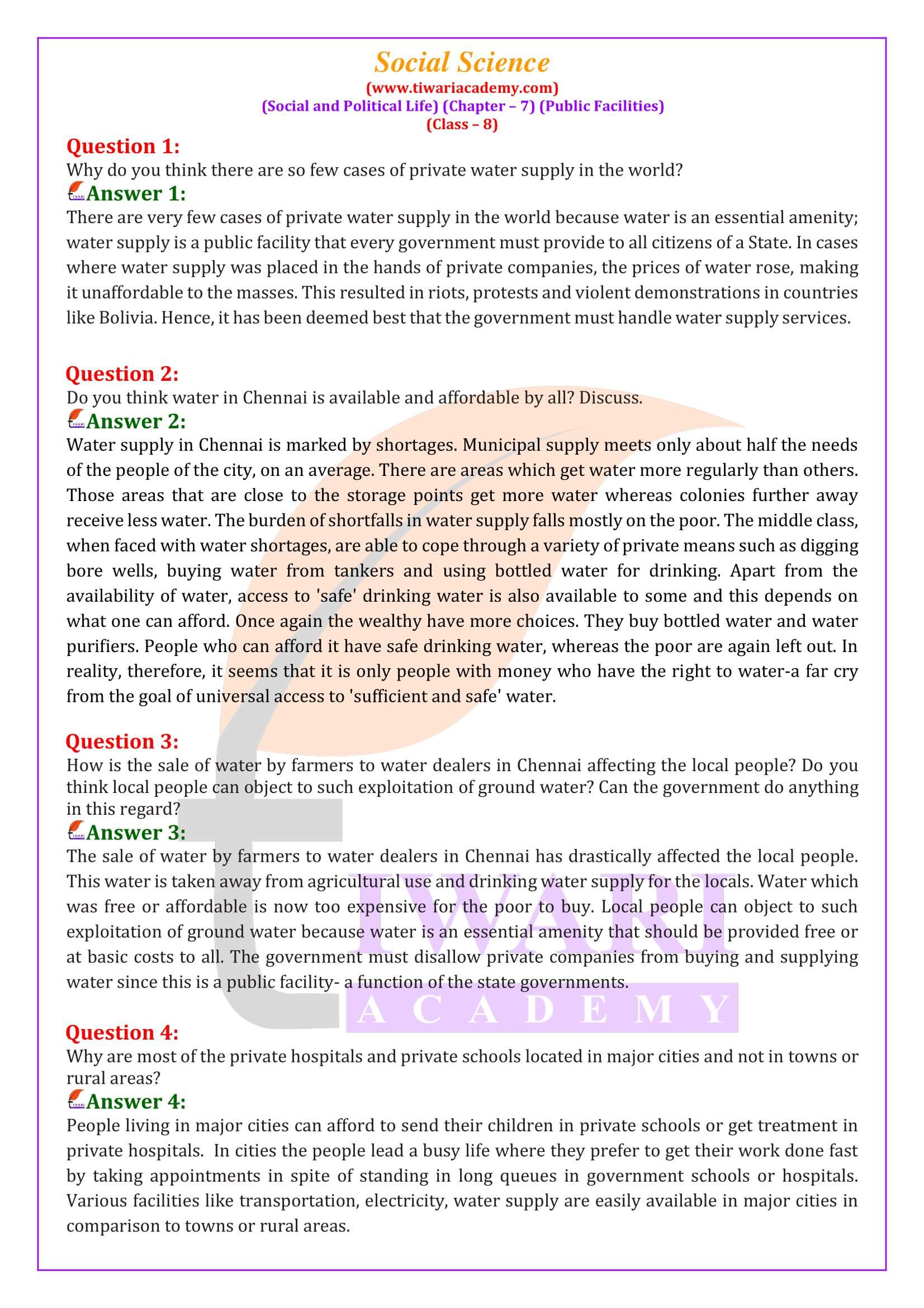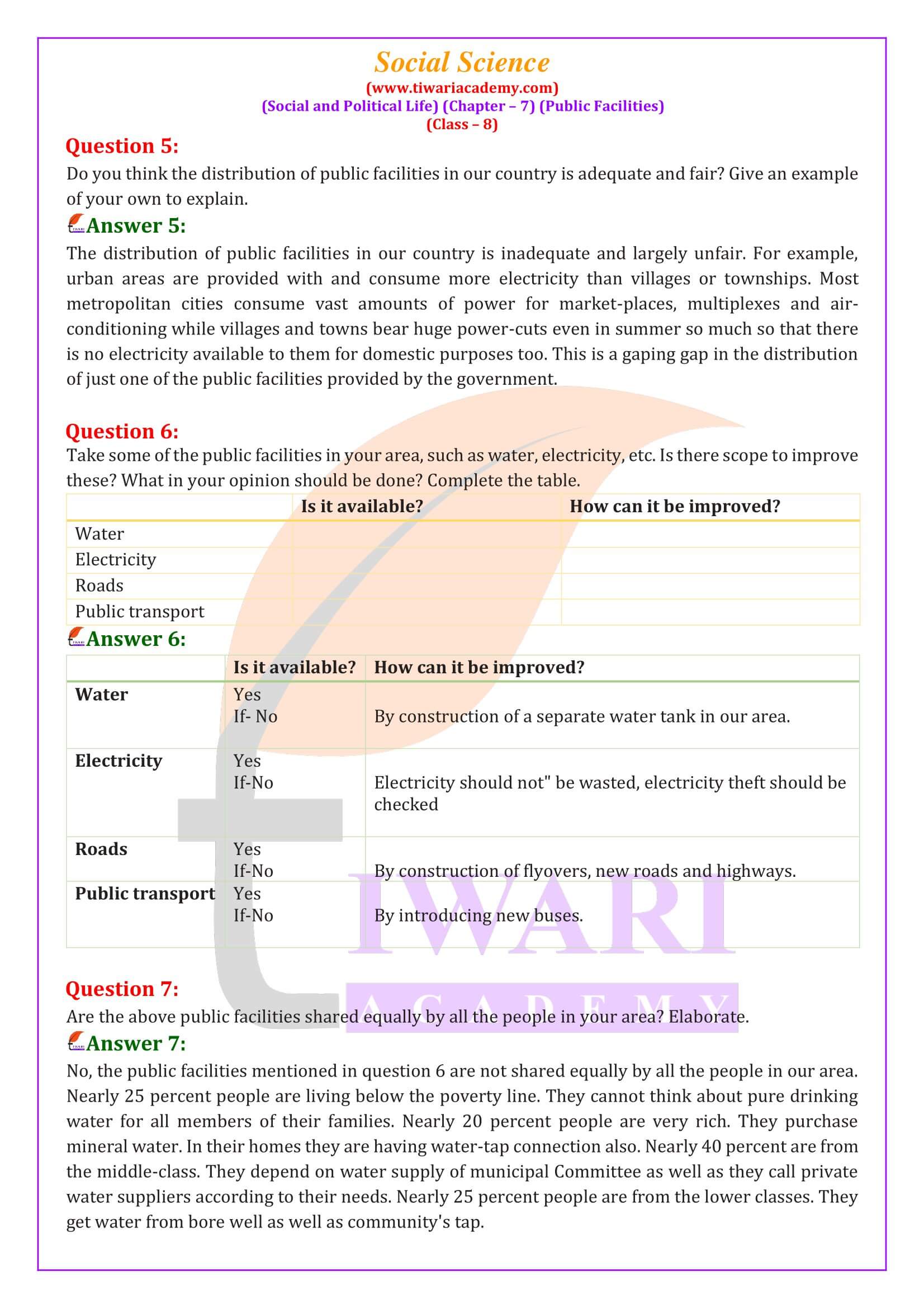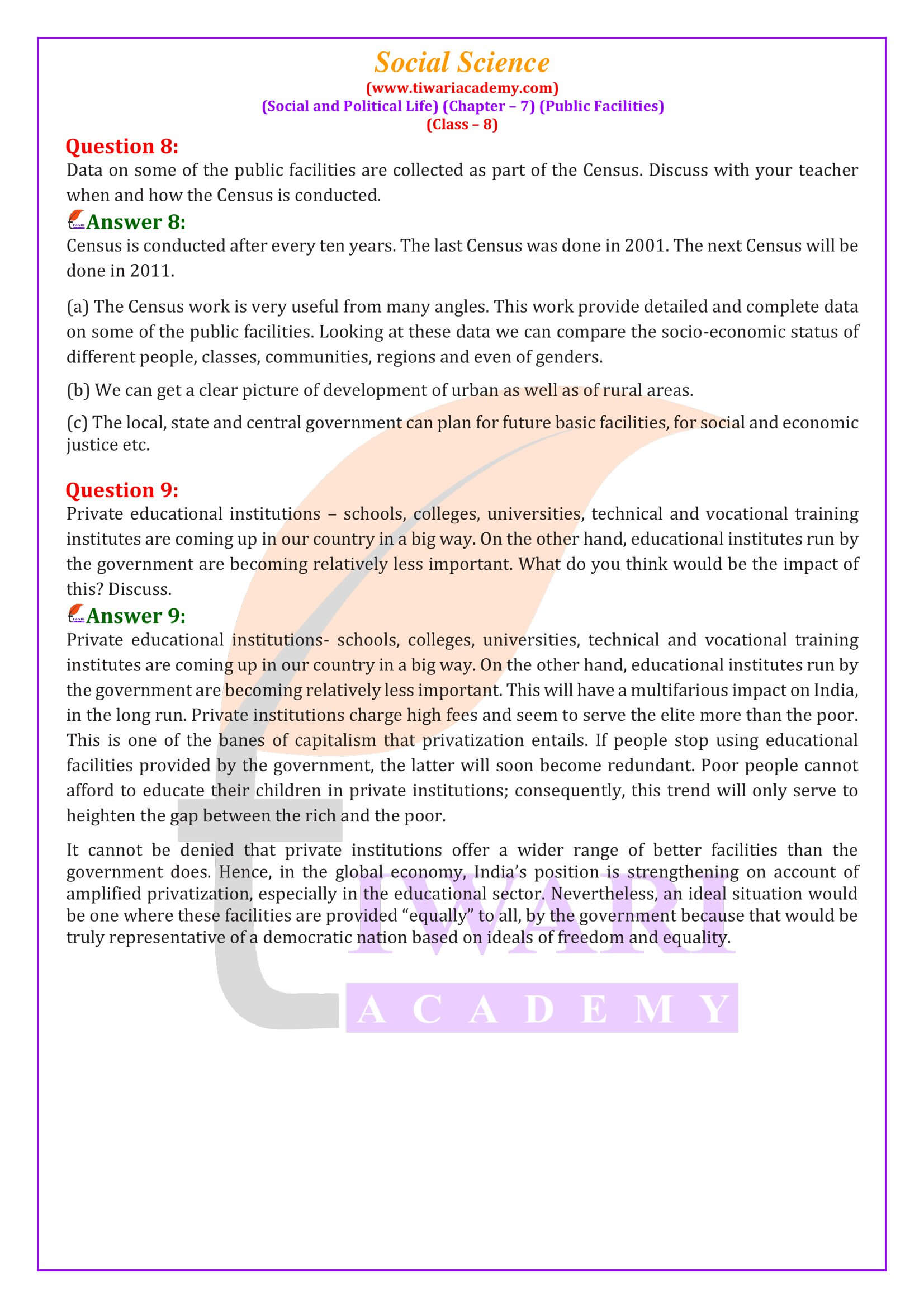NCERT Solutions for Class 8 Social Science Civics Chapter 7 Public Facilities in Hindi and English Medium (Unit 5 of Social and Political Life – III) updated for academic session 2025-26. Class 8 Political Science chapter 7 is modified and revised as per the rationalised NCERT books published for 2025-26 exams.
NCERT Solutions for Class 8 Social Science Civics Chapter 7
| Class: 8 | Political Science |
| Subject: | Social Science – Civics |
| Chapter 7: | Public Facilities |
| Academic Year: | 2025-26 |
Extra Questions on 8th Civics Chapter 7
What are Public Facilities?
Like water, there are other essential facilities that need to be provided for everyone. Last year you read about two other such facilities: healthcare and sanitation. Similarly, there are things like electricity, public transport, schools and colleges that are also necessary. These are known as public facilities.
What are the Government’s Role in providing Public Facilities?
Public facilities are so important, someone must carry the responsibility of providing these to the people. This ‘someone’ is the government. One of the most important functions of the government is to ensure that these public facilities are made available to everyone.
What are the water problems facing in urban area?
The shortage in municipal water is increasingly being filled by an expansion of private companies who are selling water for profit. Also common are the great inequalities in water use. The supply of water per person in an urban area in India should be about 135 litres per day (about seven buckets) – a standard set by the Urban Water Commission. Whereas people in slums have to make do with less than 20 litres a day per person (one bucket), people living in luxury hotels may consume as much as 1,600 litres (80 buckets) of water per day.
Class 8 Civics Chapter 7 Question Answers
CBSE NCERT Solutions for Class 8 Social Science Civics Chapter 7 Public Facilities is given below in updated form for session 2025-26. Download these NCERT solutions for offline use or use as it is without downloading online.
Important Questions on 8th Civics Chapter 7
Why do you think there are so few cases of private water supply in the world?
There are very few cases of private water supply in the world because water is an essential amenity; water supply is a public facility that every government must provide to all citizens of a State. In cases where water supply was placed in the hands of private companies, the prices of water rose, making it unaffordable to the masses. This resulted in riots, protests and violent demonstrations in countries like Bolivia. Hence, it has been deemed best that the government must handle water supply services.
Do you think water in Chennai is available and affordable by all? Discuss.
Water supply in Chennai is marked by shortages. Municipal supply meets only about half the needs of the people of the city, on an average. There are areas which get water more regularly than others. Those areas that are close to the storage points get more water whereas colonies further away receive less water. The burden of shortfalls in water supply falls mostly on the poor. The middle class, when faced with water shortages, are able to cope through a variety of private means such as digging bore wells, buying water from tankers and using bottled water for drinking. Apart from the availability of water, access to ‘safe’ drinking water is also available to some and this depends on what one can afford. Once again the wealthy have more choices. They buy bottled water and water purifiers. People who can afford it have safe drinking water, whereas the poor are again left out. In reality, therefore, it seems that it is only people with money who have the right to water-a far cry from the goal of universal access to ‘sufficient and safe’ water.
How is the sale of water by farmers to water dealers in Chennai affecting the local people? Do you think local people can object to such exploitation of ground water? Can the government do anything in this regard?
The sale of water by farmers to water dealers in Chennai has drastically affected the local people. This water is taken away from agricultural use and drinking water supply for the locals. Water which was free or affordable is now too expensive for the poor to buy. Local people can object to such exploitation of ground water because water is an essential amenity that should be provided free or at basic costs to all. The government must disallow private companies from buying and supplying water since this is a public facility- a function of the state governments.
Why are most of the private hospitals and private schools located in major cities and not in towns or rural areas?
People living in major cities can afford to send their children in private schools or get treatment in private hospitals. In cities the people lead a busy life where they prefer to get their work done fast by taking appointments in spite of standing in long queues in government schools or hospitals. Various facilities like transportation, electricity, water supply are easily available in major cities in comparison to towns or rural areas.
Do you think the distribution of public facilities in our country is adequate and fair? Give an example of your own to explain.
The distribution of public facilities in our country is inadequate and largely unfair. For example, urban areas are provided with and consume more electricity than villages or townships. Most metropolitan cities consume vast amounts of power for market-places, multiplexes and air-conditioning while villages and towns bear huge power-cuts even in summer so much so that there is no electricity available to them for domestic purposes too. This is a gaping gap in the distribution of just one of the public facilities provided by the government.
No, the public facilities mentioned in question 6 are not shared equally by all the people in our area. Nearly 25 percent people are living below the poverty line. They cannot think about pure drinking water for all members of their families. Nearly 20 percent people are very rich. They purchase mineral water. In their homes they are having water-tap connection also. Nearly 40 percent are from the middle-class. They depend on water supply of municipal Committee as well as they call private water suppliers according to their needs. Nearly 25 percent people are from the lower classes. They get water from bore well as well as community’s tap.
Data on some of the public facilities are collected as part of the Census. Discuss with your teacher when and how the Census is conducted.
Census is conducted after every ten years. The last Census was done in 2001. The next Census will be done in 2011. (a) The Census work is very useful from many angles. This work provide detailed and complete data on some of the public facilities. Looking at these data we can compare the socio-economic status of different people, classes, communities, regions and even of genders. (b) We can get a clear picture of development of urban as well as of rural areas. (c) The local, state and central government can plan for future basic facilities, for social and economic justice etc.
Private educational institutions – schools, colleges, universities, technical and vocational training institutes are coming up in our country in a big way. On the other hand, educational institutes run by the government are becoming relatively less important. What do you think would be the impact of this? Discuss.
Private educational institutions- schools, colleges, universities, technical and vocational training institutes are coming up in our country in a big way. On the other hand, educational institutes run by the government are becoming relatively less important. This will have a multifarious impact on India, in the long run. Private institutions charge high fees and seem to serve the elite more than the poor. This is one of the banes of capitalism that privatization entails. If people stop using educational facilities provided by the government, the latter will soon become redundant. Poor people cannot afford to educate their children in private institutions; consequently, this trend will only serve to heighten the gap between the rich and the poor. It cannot be denied that private institutions offer a wider range of better facilities than the government does. Hence, in the global economy, India’s position is strengthening on account of amplified privatization, especially in the educational sector. Nevertheless, an ideal situation would be one where these facilities are provided “equally” to all, by the government because that would be truly representative of a democratic nation based on ideals of freedom and equality.
Important Notes on 8th Civics Chapter 7
Water as Part of the Fundamental Right to Life
The Constitution of India recognises the right to water as being a part of the Right to Life under Article 21.
This means that it is the right of every person, whether rich or poor, to have sufficient amounts of water to fulfil his/her daily needs at a price that he/she can afford. In other words, there should be universal access to water.
Water is essential for life and for good health. Not only is it necessary for us to be able to meet our daily needs but safe drinking water can prevent many water-related diseases. India has one of the largest number of cases of diseases such as diarrhoea, dysentery, cholera. Over 1,600 Indians, most of them children below the age of five, reportedly die every day because of water-related diseases. These deaths can be prevented if people have access to safe drinking water.






